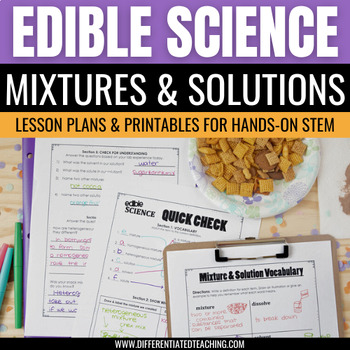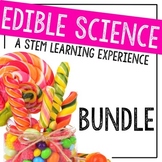Mixtures & Solutions: Hands-on Edible Science Lab for a 5th Grade STEM Classroom
- PDF
What educators are saying
Also included in
- This collection of edible science experiments allows students to explore important STEM concepts in a fun and engaging way. This collection consists of the following individually available lessons:Edible Science: MatterEdible Science: Mixtures and SolutionsEdible Science: Plate TectonicsEach individPrice $9.99Original Price $13.35Save $3.36
Description
Mixtures and solutions activities - Your students will love this hands-on experience to help them learn about the science concepts related to mixtures and solutions.
With a focus on developing science vocabulary, these activities have students explore mixtures and solutions to develop a deeper understanding. Students have fun making their own unique mixture, leaving them with a memorable experience that helps the concepts stick.
Product Contents
- Teacher's Guide w/ objectives, vocabulary, materials and technology resources
- Step-by-step lesson plans for running the mixtures & solutions lab
- Vocabulary word wall cards in color & blackline
- Student vocabulary cards (2 versions)
- Mixtures & solutions vocabulary flip book for science journals
- Matching activity/game to review key terms
- Student worksheets for assessment and progress monitoring
- Answer keys for easy grading
Key Concepts:
- What is a mixture? What are some examples of mixtures I see in my world?
- What is a solution? What are some examples of solutions I see in my world?
- How are heterogeneous mixtures similar and different than homogeneous mixtures?
- What are solutes and solvents and how do they combine to make solutions?
Vocabulary Included:
- mixture
- homogeneous mixture
- heterogeneous mixture
- solution
- solvent
- solute
- dissolve
- solubility
Click the preview to learn more!
You can also buy this pack as a part of my Edible Science bundle here. In addition to mixtures and solutions, the bundle covers these science topics:
✔States of Matter & their Changes
✔ Forces that Change the Earth
*****************************************************************************
Terms of Use:
© Rebecca Davies. All rights reserved by author. These materials are intended for personal use by a single classroom only. Copying for more than one teacher, classroom, department, school, or school system is prohibited. For use in multiple classrooms, please purchase additional licenses. This product may not be distributed or displayed digitally for public view. Failure to comply is a copyright infringement and a violation of the Digital Millennium Copyright Act (DMCA). Clipart and elements found in this PDF are copyrighted and cannot be extracted and used outside of this file without permission or license. See product file for clip art and font credits.






